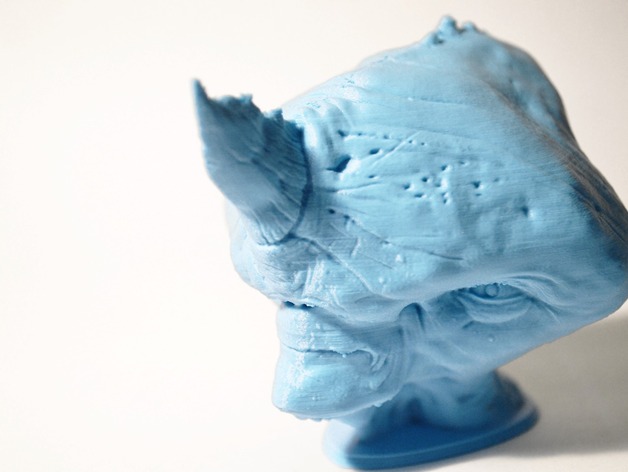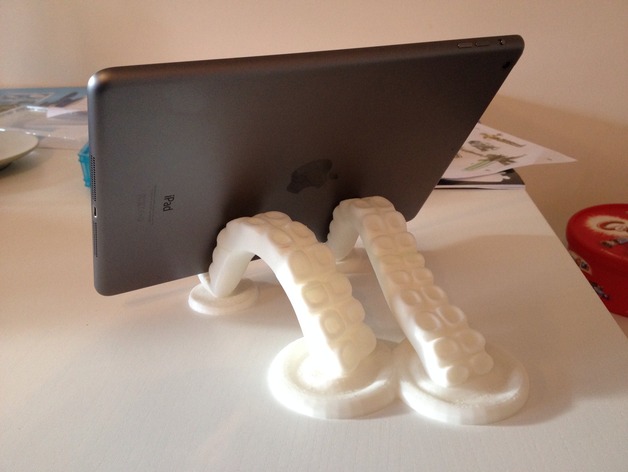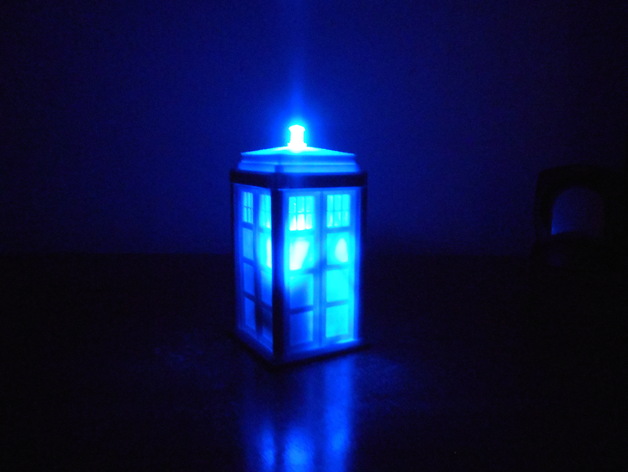User:Las5661/Blog
Contents
Blog 1: Some awesome things found on Thingiverse
Thingiverse is a website used to share files of 3D objects people have designed and printed.
Something Amazing/Beautiful
I'm amazed! For anyone who knows me, they know I am a huge Halo fan. The fact that someone was able to make this out of 3D printed parts leaves me speechless.
Design Here: Halo 4 Helmet Full Size
Something Funny and Strange
I'm not exactly sure what/who Rhino Man is, but this printed bust sure does look strange to me.
Design Here: RhinoMan
Something Useless
It's cool to look at but I can't think of any practical use for it.
Design Here: Six Handles Fancy
Something Useful
This is probably the most interesting tablet stand I've ever seen.
Design Here: Octopus Tablet Stand
Something that surprised me
As a Doctor Who fan, this is awesome to begin with. What surprised me the most about it is that it was printed using a glow in the dark plastic and then wired with blue LEDs inside of it to give it the glowing effect.
Design Here: Tardis
Blog 2: OSE Project Discussion
A) General Impression of the OSE Project
In general, the OSE project strikes me as a unique idea that could impact 3rd world and developing countries in a very good way. The amount of contributions made to the project by people other than Marcin was also incredible. Upon considering how this project will hold up in the future, I find it incredibly likely that the large companies making the more expensive commercial products will not be too happy about this venture and may go so far as to try to shut down the project. Companies such as John Deere would not like it if their products began to be beaten out by the cheaper alternative of making your own tractor. Thinking business wise, it would make sense to prevent this project from continuing in the long run, or risk losing customers/business.
After reading about the project in more depth on their website at http://blog.opensourceecology.org/, it seems that the community behind the project has been increasing at a steady rate since its inception. I commend the fact that there is a full-time group of people willing to help the project. These people have taken up positions that include project managers and operations managers. With this amount of support and leaders, I believe the OSE community can continue to increase for at least the next few years.
I decided to research the tractor a bit more and see just how easy it would be to create my own. After reading through a bit of the manual, it doesn't seem like it would be as easy to fabricate my own tractor as I initially thought. Although it would definitely be a challenge to create, with enough time and resources, it could be done. If a part were to break during the creation of the tractor however, someone without experience in fabricating and with no concept of how a tractor works, the tractor might never be able to finished. Considering I do not have an extensive amount of manufacturing experience, I feel that it would be extremely hard for someone without past experience to accomplish this project.
B) New Yorker Article and Marcin's Response
In Emily Eakin's article in the New Yorker at http://www.newyorker.com/reporting/2013/12/23/131223fa_fact_eakin, a more doubtful critique of Marcin’s ideology and tendencies is written rather than a report on his and the project's accomplishments. In the article, she does raise a valid point however; she says that, "among the obstacles he has faced is a dearth of skilled acolytes: the people who show up at his farm typically display more enthusiasm for his ideas than expertise with a lathe or a band saw." I for one would fall into this category; while being able to work on this project would be awesome, I wouldn't bring a lot of know how to the table. I believe that it was unnecessary for her to discuss his journaling tendencies or mock his food consumption however.
Marcin responded to this article at http://opensourceecology.org/wiki/New_Yorker_-_Article_Response. In general, it seemed to be a good response to the article critique. At the end of the article, Marcin says, “I am proposing a much more optimistic representation of our work than the social melodrama that the article appears to emphasize.” While I can see why a person in Marcin's position would never focus on the problems ahead of the project team, but at some point, he may not be able to remain blind to the many problems that could prevent the success of his project. Again, I find fault with what Marcin says regarding average people rising to the occasion and creating their own machines. I, being an average person, do not see myself as currently capable of making a machine such as a tractor. Marcin has a Ph.D, as well as years of experience with machines and blueprints; so he is obviously an intelligent guy. If his definition of average means people with excellent design skills, as well as years of background experience with machines, then his statement would be fine. Unfortunately, that is not the standard definition of "average".
C) PSU Club Possibilities
While there is quite a large number of organizations and clubs at Penn State, including THON and the 3D Printing Club to name just 2, I believe an OSE club might garner some interest, but I believe that they would run into problems regarding what I expressed above. Yes, many people would want to help out and build something, but with current experience, limited funds and places to manufacture, and limited time beside school work, I'm skeptical that a project of any size could be finished. If I were to contact a particular Penn State faculty member in order to garner support for such a club however, I would approach Dr. Brennan first. He was my professor for Industrial Robotics and for Vehicle Dynamics, as well as the leader of the autonomous vehicle research team. I would approach him first because he seems like someone who is always willing to push the envelope regarding design, programming, and invention.
Blog 3: 3D Printed Robohand
Who, When, and Where
The Robohand design was created by Ivan Owen and Richard Van As. The first prototype of their design was made out of metal and was made in November 2012 while the first 3D printed version was made in January 2013. Ivan Owen did his work on the Robohand from Seattle, Washington, while Richard Van As worked from Johannesburg, South Africa.
Where Could I Go To Get One
The designs for the Robohand can be found on the thingiverse website and were posted by MakerBot.
The design can be found here: Robohand
News Articles
By doing a simple google search for robohand news articles, many links can be found related to this technology. The links returned by google range from articles covering hand prostheses for little kids to articles covering 3D printed beaks and legs for animals such as eagles and ducks.
This link for example goes to an article about a little girl who was given a 3D printed robotic: Robotic Hand
This link goes to an article about a group of people who 3D printed legs and webbed feet for disabled ducks: Legs for Ducks
This link goes to an article about an eagle who received a 3D printed beak to replace the top half of its beak that had been lost after it was shot in the face by a poacher: 3D Printed Beak
Blog 4: Review of Classmate's Blog 2s
Tony Armlin
After reading through Tony's Blog 2 responses, I can easily assume that Tony is on board with the OSE project. Based on his responses, he seems to think it's a great idea and is all for it. His responses were concise and answered each question that was posed to us but he also didn't embellish or expand on anything to what I would consider a noteworthy extent.
Yuan Chai
I found Chai's responses to the questions posed to us in Blog 2 to be rather insightful. Something noteworthy that Chai discussed in his blog was that he finds the OSE project to be a waste of resources. He thinks that Marcin hasn't taken enough into account regarding the project. Chai lists a few important things that he thinks Marcin has overlooked or just not professed on a public scale such as the economic cost of the project, the energy consumption, and the factor of safety. Chai also finds the same fault with the project as me; the average person wouldn't have the experience or know-how to complete these projects. Chai goes a step further than me however and references another example which is a powercube. He provides a link to this powercube example on his Blog 2 page.
Todd Troutman
Something that Todd stated in his Blog 2 that I found to be noteworthy was a more poignant discussion regarding the New Yorker's article about Marcin. Todd discussed in his blog that the article not only points out many of the faults with the project, but also how Marcin seems to be set in his ways to the point of alienating other people and not addressing the faults that have been expressed regarding the OSE project.
Graham Deever
In Graham's Blog 2, he notes how, if the project were to be implemented correctly, it could allow developing countries and the developing parts of the world to develop at a much quicker pace. He also made a note that this same kind of project could possibly be used in the future for developing other planets for a human colony/society which I found to be a really interesting way of looking at it.
Kevin Moyer
After reading through Kevin's blog, I found that he discussed the same pitfall that I found with the project for the majority of his Blog 2. I did note however that he went into a greater amount of detail than I did regarding this pitfall. Kevin explained the specific experiences one would most likely need in order to complete one of these OSE projects and also explained what parts of the tractor's construction he as a mechanical engineering student at Penn State didn't even understand.
Jessica Mewkalo
What I found to be noteworthy in Jessica's Blog 2 responses was the fact that she considered how the OSE project could effect the economy in the long run. She states that if everyone started building their own machines, companies (John Deere being a good example when considering the tractor) would go out of business. I thought this was a really realistic way to look at how this project would effect society.
Eva Abeniacar
While the opinion that Eva expresses in her Blog 2 is the opposite of mine, I did find it noteworthy and agreeable that, if more people were to become involved with this project and work towards its advancement, the better it would become.
Nam Pham
Nam went over many good points in his Blog 2 responses but we shared most of the same view points and discussion topics.
Dongao Yang
From the beginning of his Blog 2 responses, Dongao makes it clear that he is not a fan of the OSE project. He professes in his blog that there are too many pitfalls with the project for him to have a positive view of it. Two of the most noteworthy pitfalls that he talks about concern durability and safety. He explains that open source is okay for things like 3D printing; if one operates a 3D printer incorrectly, there isn't that large of a safety hazard risk. When you get into the things that the OSE project concerns such as tractors, open source isn't such a good idea and should be left to the professionals.
Blog 5: Review of the 3D Printing Media Timeline
Upon first skimming through the timeline, I was surprised to see that 3D printing dates all the way back to 1984. I found this surprising because I hadn’t heard of 3D printing before my sophomore year of college in 2011. The media timeline timeline can be found on the Scrugmembers wiki page.
1) In my opinion, would say Chuck Hull’s invention of the first 3D printer on March 11, 1986 was most likely the largest contribution to 3D printing and is therefore the most important event in its development as a whole. While it could be argued that Chuck's development of the method to print 3D objects using digital data is the most important contribution, I believe that the theoretical process would not have been so widely known without the invention of the physical machine. I also found it interesting that the same method of adding one layer at a time was developed 30 years ago and is still used by the various forms of 3D printers today. I’m amazed that a method developed many years before I was born is still so widely used.
2) When considering an event that may have not been that important to the development of 3D printing, it would be my opinion that the CNN article from 2005 may have been a bit of an exaggeration when considering 3D printing. The title of the article, “The Machine That Can Copy Anything,” seems a bit bold and presumptuous. While I can understand that the article's title is meant to draw in readers, I still believe that the title over exaggerates the capabilities of 3D printers. Even if this were to have been written more presently, I would still be of the opinion that the title is still an exaggeration of the current capabilities. Upon reading the article, I realized that it didn’t really relate to the title and that it was fortunate that the advancements of 3D printing were being publicized. From reviewing the timeline since the release of the article, there has been quite a growth in 3D printing technology.
3) The thing I found to be the most interesting was the possibility to print materials other than plastic such as food or artificial organs made from arranging sugar in a lattice orientation. The benefit to humanity if we were able to print food on a large scale would be huge and could help to end starvation. Personally, I would be in support of a project that would supply 3D printers to third world countries for the purpose of creating food for those in danger of starvation. When thinking about what we could also do with the ability to 3D print artificial organs, the benefits would be enormous. Donors would no longer be needed and the artificial organs could be printed to fit a specific person. This would make it so that the risk of one's body not responding or accepting the transplanted organ from a donor would no longer be an issue. These kinds of topics are definitely some things that I would be really interested to learn more about.




